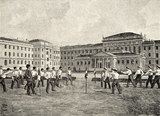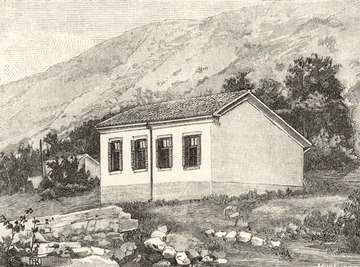Parallel worlds: literacy as a yardstick for development
-

Coelestin Medović: Pupils of a gymnastics class before the New Grammar School in Zagreb, illustration, 1902
Copyright: Schloß Schönbrunn Kultur-und Betriebsges.m.b.H./Fotograf: Alexander E. Koller
-

Julius Háry: The reading room of the Budapest University Library, illustration, 1893
Copyright: Schloß Schönbrunn Kultur-und Betriebsges.m.b.H./Fotograf: Alexander E. Koller
In view of the high level of illiteracy within the population as a whole, the Habsburg Monarchy lagged behind other western European states. The vast regional differences in literacy was a characteristic feature.
Whereas only around 1 per cent of the population of the German Reich in 1899 could not read and write and illiteracy was deemed to have been officially eliminated in 1912, it remained a massive problem in Austria-Hungary.
Educational opportunities in the Monarchy were extremely unequal. There were great differences between the central regions and the weakly structured periphery. Not only were the possibilities for acquiring higher education there extremely limited, but in many cases even access to elementary education was also practically non-existent. It was not until around 1900 that a basic education infrastructure was sufficiently developed at the edges of the empire for the demand for compulsory schooling, which had been defined by law with the introduction in 1869 of an obligatory eight years of school, to be met in practice. In 1900 only 75 per cent of school-age children actually attended primary school, rising to 88 per cent by 1910.
Apart from the difference between the centre and the periphery, ethnicity was also a major factor. Educational opportunities were not taken advantage of equally by the different population groups, above all because of the imbalance in social development of the individual language groups. In some ethnic groups, the insistence on the right to schooling in the native language brought about an increase in educational possibilities. Because of the parallel German and Czech schools, a positive cultural by-product of the language dispute, bilingual Bohemia, for example, had the highest literacy levels. On the eve of the First World War, around 95 per cent of the two language groups were able to read and write.
At the other end of the scale, fewer than 30 per cent of the population of the south and south-east of the empire were literate. The highest levels of illiteracy were to be found in politically and economically underprivileged language groups like the Serbo-Croats, Romanians and Ruthenians, who had a poorly developed network of educational institutions in their own language.
There was a grave imbalance in particular in Hungary. In spite of the legal requirement, fewer than 50 per cent of children attended school in 1870, and 68 per cent of the population were illiterate. Despite efforts to improve the situation, the Hungarian half of the empire lagged behind the Austrian half in terms of education. This was due, amongst other things, to the state education policy in Hungary, which followed the general Magyarization trend and made it difficult for the non-Hungarian language groups to obtain an education in a language other than Hungarian.
Another indication of the social backwardness of disadvantaged ethnic groups was the fact that the proportion of women among the illiterate populations was much higher than in areas with greater literacy, where the levels of illiteracy among men and women were almost equal.
Ethnicity was not the only marker. Membership of a confessional group influenced the level of literacy, as the 1910 census clearly reveals. The Jews in Hungary had a literacy rate of 75 per cent, the highest for the country as a whole. Protestants also had high literacy levels (73 per cent for the Augsburg Confession, 69 per cent for the Helvetian Confession and 63 per cent for the Unitarians). The Roman Catholics, who were the largest confessional group, had a literacy level of just 61 per cent, and the eastern Churches were even worse off, with just 35 per cent of the orthodox and 28 per cent of the Greek Catholic Christians.
Translation: Nick Somers
Rumpler, Helmut: Eine Chance für Mitteleuropa. Bürgerliche Emanzipation und Staatsverfall in der Habsburgermonarchie [Österreichische Geschichte 1804–1914, hrsg. von Herwig Wolfram], Wien 2005
Seger, Martin: Räumliche Disparitäten sozioökonomischer Strukturen in der Spätphase der Habsburgermonarchie. Die Gleichzeitigkeit des Ungleichzeitigen, in: Rumpler, Helmut/Seger, Martin (Hrsg): Die Habsburgermonarchie 1848–1918, Band IX/2: Soziale Strukturen, Wien 2010, 27–44


